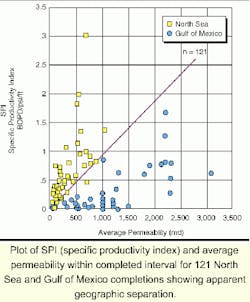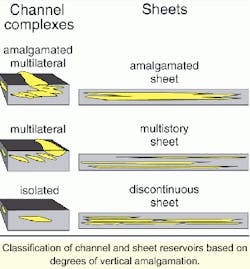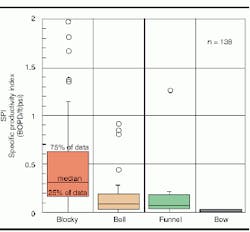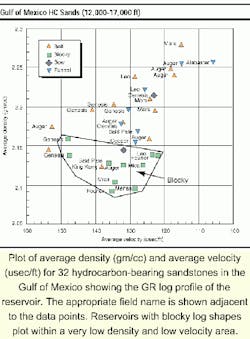GEOSCIENCES: Deepwater pay thicknesses, seismic response may not indicate point of highest productivity
Stephen P.J. Cossey
Cossey & Associates Inc.
Pay thickness in deepwater clastic reser-voirs does not always correlate with high flow rates. In fact, producing reservoirs in the North Sea and Gulf of Mexico show variable correlation between net pay thickness and absolute flow rate. A 100 ft thick net pay zone can have plateau oil flow rates of between 3,000 b/d and 28,000 b/d.
The North Sea fields seem to show a slightly better correlation between net pay and absolute flow rate than do the Gulf of Mexico fields. This observation conflicts with one of the goals of field development, which is to correlate known net pay (from wells) with seismic response in order to locate future development wells in areas of thickest pay, where it is assumed that the highest flow rates will be obtained.
Part of this variability in flow rate is because deepwater clastic reservoirs are architecturally complex. This complexity makes the process of appraising new discoveries a difficult balance between understanding the reservoirs and minimizing the number of expensive appraisal and development wells. It is therefore increasingly important to understand the lessons that can be learned from analogue fields and reservoirs. It is these analogues that provide us with hard data on producibility and performance in architecturally different deepwater reservoirs such as sheet sands, channel complexes, and levees.
Many geological and engineering factors other than pay thickness also affect flow rates. It would seem intuitively obvious that a reservoir that is drawn down at a higher pressure will produce at a higher rate than one that is drawn down at a lower pressure. It is also widely believed that permeability is the main factor controlling flow rate. In fact, in the radial flow equation, there are at least eight variables that define the flow around the wellbore in a reservoir (Amyx, Bass & Whiting, 1960).
If a true comparison of reservoir performance is to be made, we must normalize the data for as many of the variables in the radial flow equation as possible. Reservoir performance studies have not traditionally used normalized flow rates for comparisons because the detailed data needed for such a study is usually kept confidential by the operator and is rarely published on enough reservoirs to be statistically valid. Rates also may be limited due to a variety of facilities constraints such as water/gas separation, sand produc-tion, and pipeline capacity. These facility bottlenecks may affect some of the correlations.
Study details
In this study, data from more than 159 completions of deepwater clastic reservoirs from eight Gulf of Mexico fields (Bullwinkle, Cerveza, Ewing Bank 826, Pompano, Grover, Snapper, Mars, and Lena) and three North Sea fields (Forties, Miller, and Magnus) were analyzed.
In the radial flow equation, average permeability (mD) over the completed interval was used instead of effective permeability (Keff) and net sand open to perforations (ft tvd) was used instead of thickness (h). The flow rates were normalized for drawdown, thickness, and, in some cases, permeability to determine what type of reservoir provides the best performance.
Other variables, such as architectural element type, net-to-gross, log shape, and permeability, were compared to these normalized rates to determine if any "rules of thumb" could be applied to reservoir producibility. Some preliminary conclusions from these comparisons were published by Byrd & Cossey (1994).
Variables
The plateau flow rate of an interval was determined from the monthly production plot for each completion. The production profiles were often very variable in shape, but the average plateau rates were always estimated visually from the profiles. Dual completions were used if flow percentages could be assigned to commingled completions using spinner surveys. Gas completions were avoided, and care was taken to ensure that flow rates did not increase due to increased gas-oil-ratio.
Net sand open to perforations was calculated by summing all the perforations within the reservoir interval and then calculating the net sand within that summed interval. The thickness of a perforated interval was corrected to true vertical depth (TVD) in deviated wellbores.
The specific productivity index (SPI) is defined as oil bbl per day/psi of drawdown/ft perforated. This normalizes the flow rate for the effects of drawdown and thickness. SPI was calculated for each completion and was then plotted against other variables.
Permeability
High permeability within a reservoir does not necessarily mean a higher SPI. However, in the Gulf of Mexico, average core permeability within a reservoir seems to define a maximum SPI. In contrast, average core permeability within the completed intervals from the North Sea apparently define a minimum SPI. The cross-plot of SPI and average core permeability shows a very clear geographical separation bet-ween data from the two areas. There are many differences between the reservoirs in the North Sea and those in the Gulf of Mexico.
One of the main differences is that the reservoirs from the North Sea are often calcite cemented, and the Gulf of Mexico reservoirs are unconsolidated. Also, the reservoirs at Magnus, Miller, and Forties are Jurassic to Paleocene in age, thick-bedded, and fine-grained to coarse-grained, whereas the Gulf of Mexico reservoirs are Pleistocene to Miocene in age and are massive to thin-bedded siltstones to fine-grained sandstones.
Architectural elements
Reservoirs in the study were classified architecturally as either sheets or channel complexes and then further subdivided on the basis of vertical amalgamation. In channel systems, an amalgamated multilateral is generally found in higher net/gross system and is a multilateral tabular sand body connected by amalgamation surfaces. A multilateral is a multiple, laterally distributed, tabular sand body (including linear, finger, and sinuous morphologies - Berg, 1986). An isolated lateral is an isolated tabular sand body with no laterally equivalent sand bodies.
Channel complexes were further classified on the basis of orientation as either dip-oriented or strike-oriented. Multilateral dip-trending channels are multilateral tabular sand bodies with lengthwise dimensions oriented perpendicular to fluid contacts. Multilateral strike-trending channels are multilateral tabular sand bodies with lengthwise dimensions oriented parallel to fluid contacts.
In sheet systems, an amalgamated sheet is an amalgamated, extensive thin sand body. Lengths and widths are approximately equal (blanket, ovate, and lobate of Berg, 1986). A multi-story sheet is a vertically stacked, extensive, thin sand body, with approximately equal lengths and widths, separated by mudstones.
The highest average SPIs were observed in reservoirs whose architecture is interpreted as amalgamated sheets or amalgamated multilateral channel complexes. Dip-trending channel complexes also show higher SPIs than strike-trending complexes, probably as a result of better connectivity to the aquifer and possibly a better aquifer drive mechanism. In general, the results show that higher vertical connectivity of the architectural element results in a higher SPI.
Gamma ray log shape
The interpretation of architectural element type can be very subjective and may vary from interpreter to interpreter. Architectural element type is thought by many to be reflected in the general gamma ray (GR) log shape of the reservoir (Mahaffie, 1994). A simple classification of log shape (blocky, bell, funnel, or bow) is somewhat less subjective than an architectural element classification and was used to define each of the reservoirs within the study. The SPIs for each group of GR log shapes was then plotted on box diagrams
Reservoirs with blocky GR log shapes had the highest SPI's and reservoirs with funnel or bell-shaped GR logs had lower, but very similar ranges of uncertainty in SPIs. If this data is further normalized for permeability (SPI per mD), reservoirs with bow-shaped GR logs (probably channel/levee reservoirs) have a similar range of SPI to blocky-shaped logs rather than bell or funnel-shaped logs.
Gulf of Mexico examples
The GR log shapes of 32 hydrocarbon-bearing reservoirs in 12 fields or recent discoveries in the deepwater Gulf of Mexico were classified as either blocky, bell, funnel, or bow-shaped according to a basic shape classification. The average velocity and density within each reservoir interval was then calculated from the digital log data using PRIZM.
A cross-plot of average density and velocity shows that blocky-shaped GR logs plot in a well-defined part of the diagram and in a very distinct area from the other log shapes. Blocky-shaped GR logs would have the lowest acoustic impedance of the reservoirs and may be seismically distinguishable from funnel and bell-shaped reservoirs, which are shown in this study to have a much lower producibility.
This relationship was also observed by Hilterman et al., (1998) who showed that, in a single well, blocky log-shapes plotted in a very distinct area in a velocity/density cross-plot.
Conclusions
In order to compare reservoir performance from different areas, it is necessary to at least normalize the flow rates for thickness and drawdown, and compare SPIs. This study of over 159 completions in deepwater clastic oil reservoirs found that no single geological or engineering factor is associated with high normalized flow rates (SPIs).
High permeability, large tubing size, low oil viscosity, or thick net pay, by themselves, do not necessarily mean a high SPI. However, SPIs are shown to be highest in reservoirs with blocky shaped GR logs and lower, but similar, in reservoirs with funnel and bell-shaped GR logs.
SPIs in bow-shaped logs (thin-bedded levee reservoirs) are equivalent to reservoirs with blocky-shaped GR logs when they are normalized for thickness, drawdown, and permeability. If all other factors are equal, this may mean that the areal extent of levee-type reservoirs and sheet reservoirs may be very similar.
Reservoirs with blocky-shaped GR logs have lower average velocities and densities than reservoirs with funnel-shaped and bell-shaped GR logs and plot in a well-defined area on velocity/density cross-plots. Reservoirs with blocky-shaped GR logs have been shown to have the best producibility when compared to other reservoirs and, because of their acoustic impedance differences, may be distinguishable on some seismic attribute maps.
Attribute maps should be used as overlays on net pay maps to determine the best drilling locations where the highest producibility can be obtained. Wells should not just be located in areas of the thickest pay, without regard for producibility. Sometimes net pay and relative amplitude values show little or no correlation, and this may be because the seismic response is being affected by many geological factors and not merely pay thickness.
Crossplots of average permeability of perforated intervals versus SPI show that the North Sea reservoirs have higher SPIs than Gulf of Mexico reservoirs with similar permeability. This may mean that permeability in younger unconsolidated reservoirs (Gulf of Mexico and West Africa) can be used to define a maximum SPI, whereas permeability in older consolidated reservoirs (North Sea and onshore US) can be used to define a minimum SPI.
Acknowledgement
BP granted permision to publish this paper, and Steve Peacock and Mike Sweet obtained permission to release the necessary data. Tom Byrd, BP, made early contributions to this work in 1994 and prepared some figures. PanCanadian Petroleum also contributed some data.
References
Amyx, J., Bass, D., Whiting, R., 1960, Petroleum Reservoir Engineering: McGraw-Hill, New York, Toronto, London.
Archer, J., Wall, C., 1986, Petroleum Engineering: Principles and Practice: Graham & Trotman Ltd., London.
Berg R., 1986, Reservoir Sandstones: Prentice Hall, Englewood Cliffs.
Byrd, T., Cossey, S., 1994, Understanding Producibility in Turbidite Reservoirs: Improving on the Utility of Analogue Studies: AAPG Annual Convention Program with Abstracts.
Hilterman, F., 1998, Rock Property Framework for Comprehending Deep-Water Seismic Response; 1998 Spring Symposium, 14th Annual SEG Gulf Coast Technical Meeting: Geophysical Society of Houston.
Mahaffie, M., 1994, Reservoir Classification for Turbidite Intervals at the Mars Discovery, Mississippi Canyon 807, Gulf of Mexico, in P. Weimer, A.H. Bouma and R.F. Perkins, eds., Submarine Fans and Turbidite Systems: Gulf Coast Section SEPM Foundation, 15th Annual Research Conference, p.233-244.
Editor's Note: This paper was presented at the 20th Annual Bob F. Perkins Research Conference sponsored by the Gulf Coast Section, Society of Economic Paleontologist and Mineralogists, Houston, Texas, December 3-6, 2000 (reprinted with permission).






